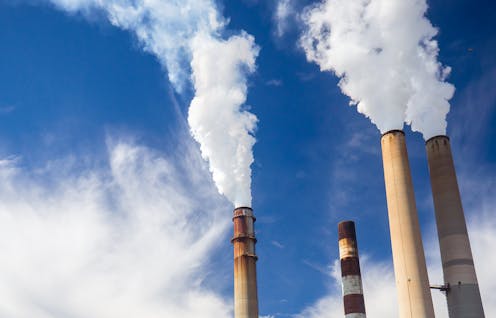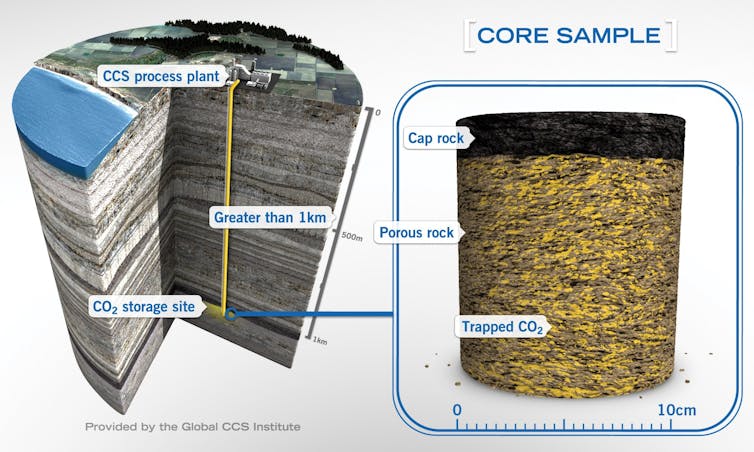EPA’s crackdown on power plant emissions is a big first step – but without strong certification, it
Fossil fuel power plants can avoid most emissions by capturing carbon dioxide and pumping it underground. But to be a climate solution, that carbon has to stay stored for thousands of years.

The U.S. government is planning to crack down on power plants’ greenhouse gas emissions, and, as a result, a lot of money is about to pour into technology that can capture carbon dioxide from smokestacks and lock it away.
That raises an important question: Once carbon dioxide is captured and stored, how do we ensure it stays put?
Power plants that burn fossil fuels, such as coal and natural gas, release a lot of carbon dioxide. As that CO₂ accumulates in the atmosphere, it traps heat near the Earth’s surface, driving global warming.
But if CO₂ emissions can be captured instead and locked away for thousands of years, existing fossil fuel power plants could meet the proposed new federal standards and reduce their impact on climate change.
We work on carbon capture and storage technologies and policies as a scientist and an engineer. One of us, Klaus Lackner, proposed a tenet more than two decades ago that is echoed in the proposed standards: For all carbon extracted from the ground, an equal amount must be disposed of safely and permanently.
To ensure that happens, carbon capture and storage needs an effective certification system.
EPA’s proposed carbon crackdown
The proposed new power plant rules, announced by the Environmental Protection Agency on May 11, 2023, are based on performance standards for carbon dioxide releases. They aren’t yet finalized, and they likely will face fierce legal challenges, but the industry is paying attention.
Power plant owners could meet the proposed standards in any number of ways, including by shutting down fossil fuel-powered plants and replacing them with renewable energy such as solar or wind.
For those planning to continue to burn natural gas or coal, however, capturing the emissions and storing them long term is the most likely option.
How CCS works for power plants
Carbon capture typically starts at the smokestack with chemical “scrubbers” that can remove more than 90% of carbon dioxide emissions. The captured CO₂ is compressed and sent through pipelines for storage.
At most storage sites, CO₂ is injected into underground reservoirs, typically in porous rocks more than 3,300 feet (1,000 meters) below the surface.

Geologists look for sites with multiple layers of protection, including impermeable rock layers above the reservoir that can prevent gas from leaking out. In some sites, CO₂ chemically reacts with minerals and is eventually immobilized as a solid carbonate.
Carbon capture and storage is currently expensive, and developing the pipeline and storage infrastructure will likely take years. But as more CCS projects are built – helped by some generous tax credits in the 2022 Inflation Reduction Act – costs are likely to drop.
The Sleipner project in the North Sea has been putting away roughly 1 million metric tons of CO₂ a year since 1996. In Iceland, CO₂ is injected into volcanic basalt rocks, where it reacts with the stone and rapidly forms solid mineral carbonates.

In the U.S., companies have been injecting CO₂ into underground reservoirs for decades – initially, as a way to force more oil out of the ground. Today, these “enhanced oil recovery” projects can receive tax credits for the CO₂ that remains underground. As a result, some now inject more carbon into the ground than they extract as oil.
While there have been no notable CO₂ releases from geologic storage, other gas storage leaks demonstrate that injection has to follow well-defined safety rules. Nothing is guaranteed.
That’s why monitoring and certification are essential.
How to effectively certify carbon storage
The EPA has rules for CO₂ storage sites, but they are focused on protecting drinking water rather than the climate. Under those rules, monitoring is required for all phases of the project and for 50 years after closing to check the safety of the groundwater and ensure that material injected underground does not contaminate it.
However, the current monitoring techniques don’t measure the amount of carbon stored, and the rules do not require that leaked carbon be replaced.
To provide more direction, we developed a certification framework designed to ensure that all carbon is stored safely and for the tens of thousands of years necessary to safeguard the climate.
We envision liability for the captured carbon dioxide shifting from the power plant owner to the storage site operator once the carbon dioxide is transferred. That would mean the storage site operator would be held liable for any leaks.
Under the framework, a certificate authority would vet storage operators and issue certificates of carbon sequestration for stored carbon. These certificates could have market value if, as the EPA suggests, power plant operators are held responsible for the carbon stored. Future regulations could expand this requirement to other emitters, or simply demand that any carbon released is cleared by a corresponding certificate showing the same amount of carbon has been sequestered.
Careful monitoring, paired with certification that requires storage site owners to make up any losses, could help avoid greenwashing and ensure that the investments meet the nation’s climate goals.
Certification can be useful for carbon stored in any quantifiable storage reservoir, including trees, oceans and human infrastructure such as cement. We believe a universal approach to certification that sets minimum requirements and responsibilities is necessary to assure that carbon is stored safely with a guarantee of permanence, regardless of how it is done.
Climate change will cost trillions of dollars, and the federal government is putting billions into research and tax breaks to encourage development of carbon capture and storage sites. To avoid dubious methods, corner-cutting and greenwashing, carbon storage will have to be held to high standards. The U.S. can’t afford to pin a large chunk of its climate strategy on carbon storage without proof.
Stephanie Arcusa receives funding from Arizona State University.
Klaus Lackner receives funding from Arizona State University and the Kaiteki Institute at ASU.
Read These Next
Midlife weight gain can start long before menopause – but you can take steps early on to help your b
What you do in the years leading up to menopause can help counter the natural hormonal effects of aging,…
Who thinks Republicans will suffer in the 2026 midterms? Republican members of Congress
The president’s party almost always loses seats in the midterms. More than two dozen Republican House…
New materials, old physics – the science behind how your winter jacket keeps you warm
Winter jackets may seem simple, but sophisticated engineering allows them to keep body heat locked in,…






